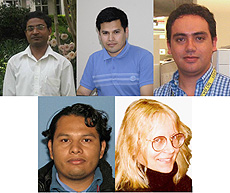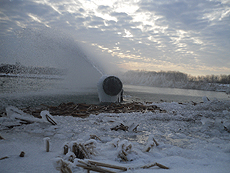Have a safe day!
Thursday, Feb. 26
1 p.m.
Computing Techniques Seminar - One West
Speaker: Ilya Volvovski, Cleversafe
Title: Big Data Challenges in the Era of Data Deluge
2 p.m.
Neutrino Seminar - WH8XO
Speaker: Andrew Hime, Pacific Northwest National Laboratory
Title: A CENNS program at the BNB
2:30 p.m.
Theoretical Physics Seminar - Curia II
Speaker: Jordi Salvado Serra, University of Wisconsin - Madison
Title: Cosmological Constraints on Newton's Gravitational Constant for Matter and Dark Matter
3:30 p.m.
Director's Coffee Break - WH2XO
4 p.m.
Fermilab Colloquium - One West
Speaker: Leonard Feldman, Rutgers University
Title: The Ongoing Electronic Materials Revolution
Friday, Feb. 27
3:30 p.m.
Director's Coffee Break - WH2XO
4 p.m.
Joint Experimental-Theoretical Physics Seminar - One West
Speaker: Alex Drlica-Wagner, Fermilab
Title: Gamma-ray Searches for Galactic Dark Matter Substructure
Visit the new labwide calendar to view additional events at Fermilab
|
|
Thursday, Feb. 26
- Breakfast: Canadian bacon, egg and cheese Texas toast
- Breakfast: Greek omelet
- Ranch house steak sandwich
- Chicken creole
- Barbecue pork spareribs
- Rustic club flatbread sandwich
- Chef salad
- Beef and rice soup
- Chef's choice soup
- Assorted pizza by the slice
Wilson Hall Cafe menu |
|
Friday, Feb. 27
Dinner
- Roasted butternut squash salad with sherry vinaigrette
- Lobster tail with lemon butter sauce
- Sauteed spinach
- Cauliflower puree
- Chocolate pot de creme with fresh berries
Wednesday, March 4
Lunch
Menu unavailable
Chez Leon menu
Call x3524 to make your reservation.
|
|
Fermilab's updated Twitter handle is @Fermilab
Fermilab has changed its official Twitter username from @FermilabToday to @Fermilab. Please update links on your websites or in your email signature to reflect the new username. The correct link is https://twitter.com/Fermilab.
|
Now accepting applications for Lab-Corps program
Lab-Corps, a new U.S. Department of Energy program that gives national lab researchers the opportunity and tools to determine if technology they have developed is suitable for commercialization, is now accepting applications.
To learn more about the Lab-Corps program, visit Argonne's Lab-Corps Web page. Applications are due by 5 p.m. Central time on Friday, March 13.
For application assistance, contact Cherri Schmidt or Aaron Sauers.
If you have questions, please contact David McCallum, Lab-Corps program manager, or Jason Pariso, Lab-Corps training advisor.
Read more about Fermilab's participation in Lab-Corps.
|
March wellness, special events and fitness classes
Complimentary Wellness
Ten-minute Employee Appreciation Chair Massage
Tuesday, March 17, 9 a.m.-1 p.m.
Curia II
Reserve your free 10-minute chair massage by emailing Jeanne Ecker or calling her at x2548.
Special Event
Spring Book Fair
Tuesday, March 31, 10 a.m.-3 p.m.
Wednesday, April 1, 8 a.m.-2 p.m.
Wilson Hall atrium
Fitness Classes
Yoga Mondays
Mondays, March 2-April 20 (one week of vacation TBD), noon-12:45 p.m.
WHGFE Training Room
$55. Register by Feb. 23.
Yoga Thursdays
Thursdays, March 5-April 23 (one week of vacation TBD), noon-12:45 p.m.
WHGFE Training Room
$55. Register by Feb. 26.
Zumba Toning
Tuesdays, March 24-April 28, noon-12:45 p.m.
Fitness Center Exercise Room
$40. Register by March 17.
Zumba Fitness
Thursdays, March 19-April 30, noon-12:45 p.m.
Fitness Center Exercise Room
$45. Register by March 12.
Muscle Toning
Tuesdays and Thursdays, March 31-May 26, 5-6 p.m.
Fitness Center Exercise Room
$82/person. Register by March 24.
Employee Club
Spring Garden Club meeting
Thursday, March 5, noon-1 p.m.
Curia II
Employee Discount
Norris Recreation Center
For more discounts, visit the employee discount Web page.
|
Higgs boson could explain matter's dominance over antimatter
From Scientific American, Feb. 20, 2015
The stars, the planets and you and I could just as easily be made of antimatter as matter, but we are not. Something happened early in the universe's history to give matter the upper hand, leaving a world of things built from atoms and little trace of the antimatter that was once as plentiful but is rare today. A new theory published February 11 in Physical Review Letters suggests the recently discovered Higgs boson particle may be responsible — more particularly, the Higgs field that is associated with the particle.
Read more
|
Does dark matter cause mass extinctions and geologic upheavals?
From Astronomy, Feb. 23, 2015
Research by New York University Biology Professor Michael Rampino concludes that Earth's infrequent but predictable path around and through our galaxy's disk may have a direct and significant effect on geological and biological phenomena occurring on Earth. In a new paper, he concludes that movement through dark matter may perturb the orbits of comets and lead to additional heating in the Earth's core, both of which could be connected with mass extinction events.
Read more
|
|
How are quarks like puppets?
 |
| The nature of the strong nuclear force is such that the energy of its field is concentrated in long thin tubes, or strings, that pull on quarks. Thinking of our two goats as a bottom quark-antiquark pair produced in a Tevatron collision, the strong nuclear force strings will pull them in certain specific directions. The other ends of the strings are connected to the outgoing fragments of the colliding proton and antiproton (not shown). Image courtesy of Megan Brain |
Disponible en español
Today's article involves strings and theory, but not string theory. Rather, today's result involves string fragmentation, an approximate description of the strong nuclear force.
Quarks pull on each other as a result of the strong nuclear force. The energy of the force field between the quarks is concentrated in a long thin tube or string-shaped volume that stretches from one quark to the other. The idea behind string fragmentation is that when quarks pull on each other, it is as if there is a string tying them together, with a force that increases with their separation.
In a paper published last summer, Jonathan Rosner of the University of Chicago pondered how these strings — strings governed by quantum chromodynamics, or QCD — might pull on bottom quark-antiquark pairs. In particular, he looked at the case where the bottom quark joins with an up and a down quark to make a particle known as the Λb (pronounced "lambda sub b") in proton-antiproton collisions. He realized that QCD strings would pull on the post-collision bottom quark in the direction of the incoming proton. The other end of the string is tied to the fragments of the proton after the collision; they travel mostly in the same direction as the incoming proton, and so they would drag the bottom quark along in that same direction. From this scenario, it is straightforward to estimate how much the string's pull would change the direction of the motion of the bottom quark and hence the direction of the Λb.
DZero has recently measured the directions of Λb particles produced at the Tevatron. The interesting thing to measure is how often the Λb is produced going in the direction that the QCD string would have pulled it (that is, in the initial proton direction) versus how often it is produced going in the opposite (antiproton) direction. It turns out that the data match the simple string-pulling prediction quite well!
—Leo Bellantoni
 |
| These scientists are the primary analysts for this measurement. Top row, from left: Avdhesh Chandra (Rice University), Eduard de la Cruz-Burelo, Jose Andres Garcia-Gonzalez (both of CINVESTAV, Mexico). Bottom row, from left: Ivan Heredia (CINVESTAV, Mexico) and Daria Ziemianska (Indiana University). |
 |
| The DZero collaboration thanks Rick Van Kooten (left) for his service in ensuring the highest quality of physics output in his role as physics convener. Rick has taken on the new responsibility of vice provost for research at Indiana University. We welcome Boris Tuchming (center, CEA/Irfu/SPP, Saclay, France) as he joins Robert Hirosky (right, University of Virginia) in this crucially important task. |
|
Ice pebbles
 |
| It's ice pebble beach at the Main Injector. Photo: Patrick Sheahan, AD |
|
|